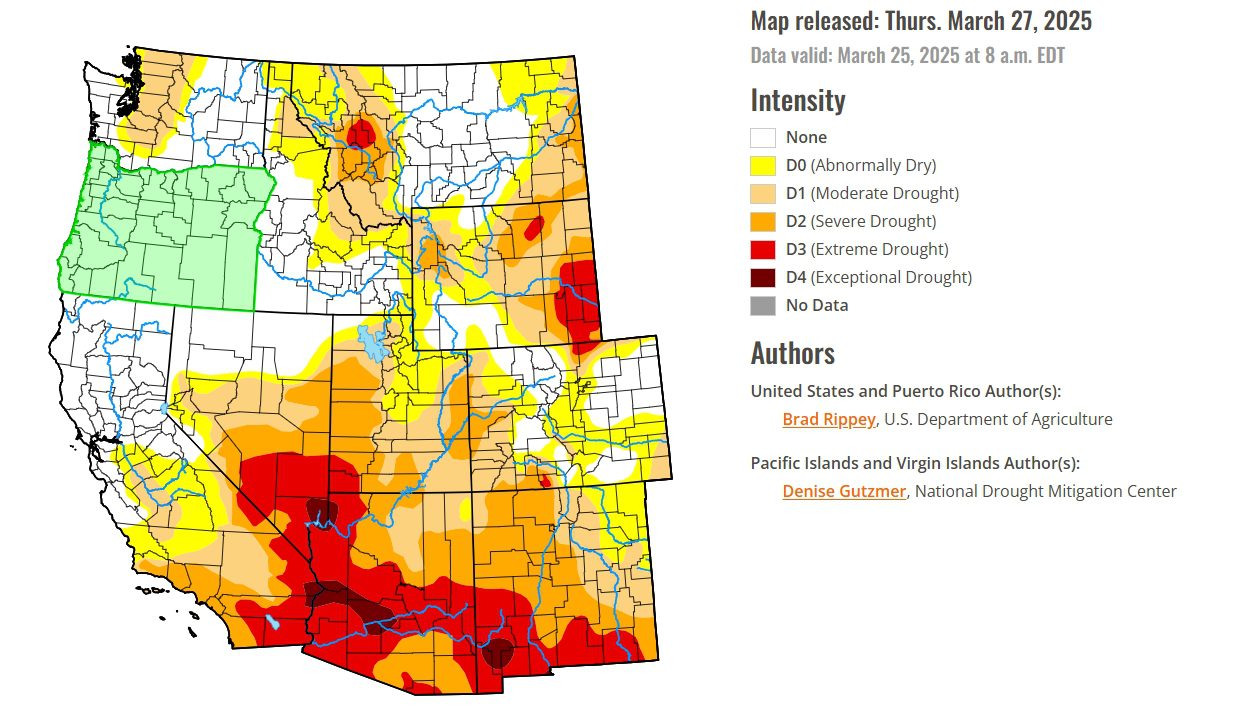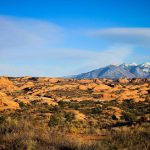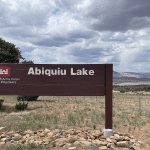- Severe drought conditions expanded in New Mexico and Utah.
- Arizona and Nevada saw no improvement amid continued dryness.
- California’s snowpack reached near-normal levels, offering some relief.
Sunday, March 30, 2025 — Drought conditions across the seven Colorado River Basin states remained stubborn or worsened during the week ending March 25, 2025, according to the latest U.S. Drought Monitor report released March 27 . Despite late-season snowfall in parts of the West, most of the Southwest remained locked in dry, windy weather, with New Mexico, Utah, and southern Nevada among the hardest hit.
. Despite late-season snowfall in parts of the West, most of the Southwest remained locked in dry, windy weather, with New Mexico, Utah, and southern Nevada among the hardest hit.
New Mexico: Rising Dust, Rising Drought.
In New Mexico, “significant increases of all drought categories were introduced,” marking a sharp turn for the worse. The state, already struggling with multiple weeks of windy and dusty conditions, saw expansion in areas experiencing moderate (D1) to extreme (D3) drought. The dry weather mirrors conditions in the southern Plains, where high winds have intensified stress on rangeland and crops.
Utah and Nevada: Worsening Outlook.
Utah also saw deterioration, particularly in central and southern regions where short-term dryness is compounding existing long-term deficits. In Nevada, drought indicators remained unchanged from the previous week, but the absence of meaningful precipitation continues to impact water supplies and range conditions. The Las Vegas Valley remains under severe drought, with dry soils and stressed vegetation prevailing.
Arizona: No Relief Yet.
Arizona remained dry, with no major precipitation events during the monitoring period. The state continues to reflect a mosaic of drought intensities, primarily in the D1 (moderate) to D2 (severe) range, especially across the northern and central regions. Conditions in southeastern Arizona also worsened slightly, driven by wind and low humidity.
Colorado: Mixed Signals.
Northern and western Colorado benefited modestly from late-season storm activity, helping improve mountain snowpack and runoff projections. However, eastern Colorado saw little change, and pockets of moderate drought persisted. Overall, the state’s water outlook remains cautiously optimistic thanks to improved snow conditions in key watersheds.
California: Strong Snowpack Bolsters Outlook.
There was some good news out of California, where the Sierra Nevada snowpack climbed to nearly 25 inches of water equivalency. According to the California Department of Water Resources, this “essentially ensured a normal seasonal accumulation,” which will bolster runoff into reservoirs serving both urban and agricultural users. While southern California remained dry, the late-season boost in snowpack marks a significant development for the state’s overall water picture.
Wyoming: Snow Helps, but Not a Cure-All.
Wyoming, particularly its northern and western reaches, saw improvement thanks to recent snowfall. The added moisture contributed to “improved mountain snowpack, more favorable spring and summer runoff prospects, and reductions in drought coverage and intensity.” However, southern parts of the state, especially near the Utah border, continue to experience moderate to severe drought.
Looking Ahead: More Dryness for the Southwest.
The forecast for the week ahead suggests continued dry weather for the Southwest, including Arizona, New Mexico, and southern Utah. According to the National Weather Service’s 6- to 10-day outlook for April 1–5, “warmer-than-normal weather” is expected across much of the southern Plains and lower Colorado River Basin. Precipitation chances are slim, meaning little relief is in sight for drought-stricken areas.
As the Colorado River Basin prepares to enter the peak of its runoff season, snowpack improvements in some areas offer cautious optimism. But for large swaths of the region, the persistence of dry, windy conditions continues to drive concerns about soil moisture, vegetation health, and long-term water supplies.
This report is based on data from the U.S. Drought Monitor, effective March 25, 2025, and reflects conditions leading up to that date. It will be updated as new information becomes available.





Leave a Reply